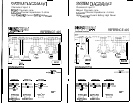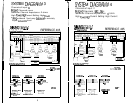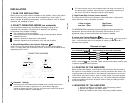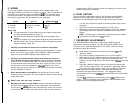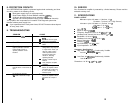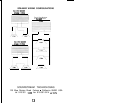
~
5. WIRING
The only tool needed to make wire terminations at the amplifier will be a flat
blade-type screwdriver and either wire strippers or a knife. When baring wires for
connection to the amplifier, remove approximately
98”
of the insulation, insert
into the terminal block, and tighten the screw. Determine from the chart below
the minimum gauge power and ground wire for your application.
up to 5’ up to 10’
greater than
IO’
Soundstream Power40
Soundstream
Soundstream
or Power80 Power40 or Power80
Power40
(4 or 8 ga.) (4 or 8 ga.)
(4
gas)
Wiring Tips
0
Use grommets when running cables through any metal or sharp plastic
to prevent accidental shorting or shearing.
0
Be certain that the cables don’t interfere with normal operation of the
vehicle.
0
Choose the location of the audio cables carefully to prevent interference
with the vehicle’s high current circuits and vehicle management systems
(engine computers, relays, etc.).
1.
Carefully run the audio and remote turn-on cables to the amplifier.
2.
Connect the speakers as shown in “Selecting Operating Modes” in section
2. Use at least a 16 gauge speaker wire, preferably a flexible multi-strand
cable, such as Soundstream Speaker 160 or Speaker 120.
3.
Carefully run the positive power cable from the battery to a fuse or a
circuit breaker and then to the amplifier. Connect the lead to the battery
via either a fuse or circuit breaker within 18 inches of the battery. The fuse
or circuit breaker value should be 40 to 50 amps. Leave the fuse out or the
circuit breaker off until the installation is
othencvise
finished. If the circuit
breaker cannot be shut off manually, do not make the final power connection
until the installation is finished.
4.
Run a ground cable for the amplifier and securely connect it to a solid
chassis ground on the vehicle. The ground cable should be the same gauge
as the power cable.
5.
Double check each and every connection.
amplifier power LED is on and the source unit is playing, you should have
sound coming from the speakers.
6. LEVEL SETTING
The input levels are adjusted by means of the input level controls located
between the RCA inputs and the speaker outputs. When the amplifier is
operated in the mono/bridged mode, only the right channel input is active.
1.
Turn the amp’s input level controls to minimum position (fully counter-
clockwise).
2.
Set source unit volume to approximately 314 of full volume.
3.
While playing dynamic source material, slowly increase the amplifier’s
input level(s) until a near maximum undistorted level is heard in the
system.
NOTE:
The best Signal to Noise ratio is achieved when the amplifier
I
input gains are set between 500 mV and 2.5 V.
7. CROSSOVER ADJUSTMENTS
The REFERENCE405 incorporates a continuously variable staggered
asymmetrical electronic crossover. The high and low pass portions of the
crossover can be adjusted independent of one another. Follow the below
procedure to adjust the crossover:
1.
Make certain the crossover is activated (see Section
ZB,
Select
Operating Modes).
2.
Set crossover frequency adjustments to the 12 o’clock position.
3.
While listening to music, adjust the high pass frequency dial for the high
pass. Select a frequency high enough to prevent damage to the
speakers, yet low enough that you are able to retain midbass in the front
speakers.
4.
Adjust the subwoofer frequency control in the same way as the high
pass. This time, listen to bass. You should find a setting that will give
you a solid sound with minimum “boom” from resonating frequencies.
Note; Many times, the best results are achieved with the high pass
frequencies set higher than the low pass. This “staggered” setting
compensates for much of the midbass resonance inherent in the automobile
environment.
You may find it necessary to readjust the crossover after listening to the
system.
The correct settings are a combination of the capabilities of the
equipment and your listening preferences.
6.
Reconnect the fuse or circuit breaker. Power up the system and look at
the green and red
LEDs,
depending on the configuration, one should be lit.
The may be a 2
-
3 second delay from the time that the source unit is turned
on to the time that the LED on the amp turns on, which is normal. Once the
10





